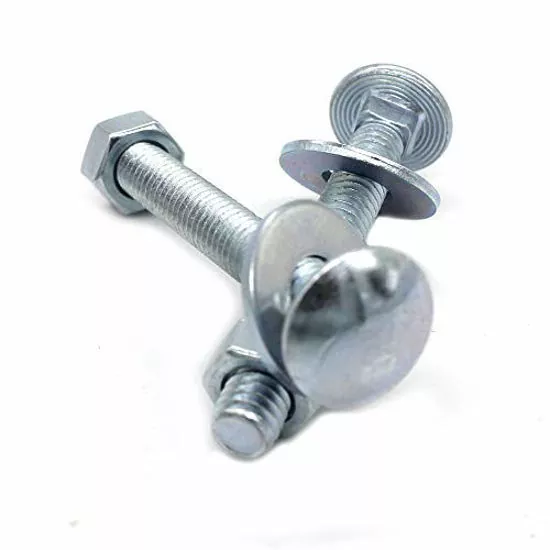Why is the Market Competition for Carriage Bolts Becoming Increasingly Fierce?
2025-09-26
Table of Contents
-
The Unassuming Workhorse: A Carriage Bolt Primer
-
Key Drivers of Intensifying Market Competition
-
Differentiating in a Crowded Market: Beyond the Basics
-
Technical Specifications: What to Look For in Quality Carriage Bolts
-
Future Outlook: Where is the Carriage Bolt Market Headed?
-
Frequently Asked Questions (FAQ)
The Unassuming Workhorse: A Carriage Bolt Primer
The carriage bolt, instantly recognizable by its smooth, dome-shaped head and square neck, is a fundamental component in construction, manufacturing, and woodworking. Its simple yet effective design prevents the bolt from turning when a nut is tightened, making it ideal for applications where one side is inaccessible. For decades, the market for these fasteners was relatively stable, dominated by a few established manufacturers. However, recent years have seen a significant surge in competition. The question is, why is the market for such a standardized product becoming so fiercely contested?
Key Drivers of Intensifying Market Competition
Several interconnected factors are fueling the competitive fire in the carriage bolt landscape.
-
Globalization and Supply Chain Dynamics: The ease of international trade has lowered barriers to entry. Manufacturers from around the world can now compete directly, often with lower production costs. This pressures domestic suppliers to compete on price, efficiency, and value-added services.
-
Fluctuating Raw Material Costs: The price of steel, the primary material for carriage bolts, is highly volatile. This volatility squeezes profit margins and forces companies to excel in supply chain management and purchasing strategies to maintain competitiveness.
-
Rising Demand from Diverse Industries: While traditional construction remains a key market, new applications in renewable energy (e.g., solar panel mounting), agricultural equipment, and DIY home improvement projects have expanded the total addressable market, attracting new players.
-
The Digital Marketplace: The rise of e-commerce platforms and online industrial suppliers has made it easier for smaller, specialized manufacturers to reach a global audience without a massive traditional sales force, further fragmenting the market.
Differentiating in a Crowded Market: Beyond the Basics
In such a competitive environment, manufacturers can no longer rely on producing a standard carriage bolt. Differentiation is key. This is achieved through:
-
Superior Material Science: Offering grades beyond the standard A307, such as high-strength Grade 5 or corrosion-resistant stainless steel grades 304 and 316.
-
Advanced Coatings and Finishes: Providing specialized coatings like hot-dip galvanizing, zinc plating, or proprietary coatings that significantly enhance corrosion resistance for harsh environments.
-
Customization and Specialization: The ability to produce non-standard lengths, diameters, or unique head markings for specific OEM (Original Equipment Manufacturer) clients provides a significant competitive edge. The integrity of every carriage bolt is critical to the safety of the final structure.
Technical Specifications: What to Look For in Quality Carriage Bolts
Discerning buyers must look beyond price and examine the technical specifications that guarantee performance and longevity. Key parameters include:
Key Product Parameters List:
-
Material Grade: Defines the mechanical properties like tensile strength and yield strength.
-
Diameter: The nominal diameter of the bolt's thread (e.g., 1/4", 5/16", 3/8").
-
Length: Measured from under the head to the end of the bolt.
-
Thread Pitch: The distance between threads, which can be coarse (UNC) or fine (UNF).
-
Finish/Coating: The type of surface treatment applied for corrosion resistance.
-
Compliance Standards: Certifications such as ASTM, SAE, or ISO that ensure quality consistency.
The following table compares common grades and their typical applications:
| Grade/Standard | Material | Tensile Strength (Minimum) | Common Applications | Key Characteristics |
|---|---|---|---|---|
| ASTM A307 Grade A | Low Carbon Steel | 60,000 psi | General construction, woodworking, low-stress applications | Economical, good for general-purpose use. |
| SAE Grade 5 | Medium Carbon Steel | 120,000 psi | Automotive, machinery, structural applications | High strength, heat-treated, marked with three radial lines. |
| ASTM A449 | Medium Carbon Steel | 120,000 psi | Similar to Grade 5 but available in larger diameters. | Often used for anchor bolts and other heavy-duty uses. |
| Stainless Steel 18-8 | Austenitic Stainless Steel | 70,000 psi | Marine environments, food processing, chemical plants | Excellent corrosion resistance. |
Future Outlook: Where is the Carriage Bolt Market Headed?
The competition is unlikely to abate. Future success will hinge on agility and innovation. We can expect a greater focus on sustainable manufacturing processes, the development of "smart" fasteners with embedded sensors, and even more sophisticated supply chain solutions that offer just-in-time delivery. The manufacturers who thrive will be those who view the humble carriage bolt not just as a commodity, but as a critical component whose quality and reliability can be a major differentiator for their customers.
Frequently Asked Questions (FAQ)
Q1: What is the main purpose of the square neck under the head of a carriage bolt?
The square neck is the defining feature of a carriage bolt. It is designed to sink into and lock against the material (typically wood or soft metal) as the nut is tightened. This prevents the bolt from spinning, allowing for one-sided assembly and ensuring a secure, vibration-resistant fit.
Q2: Can I use a carriage bolt in concrete?
While a carriage bolt itself is not designed for direct insertion into concrete, it is commonly used as part of a concrete anchor system. The bolt is inserted through a fixture into a pre-drilled hole, and an expansion shield (a sleeve placed in the concrete hole) is used to secure the nut and bolt in place.
Q3: What is the difference between Grade 2 and Grade 5 carriage bolts?
The primary difference is strength. Grade 5 carriage bolts are heat-treated, giving them a significantly higher tensile strength (approximately 120,000 psi) compared to Grade 2 (approximately 60,000 psi). Grade 5 bolts are essential for high-stress structural applications, while Grade 2 is suitable for general, low-stress uses.
If you are very interested in Hangzhou TR Industrial Trade's products or have any questions, please feel free to contact us.




